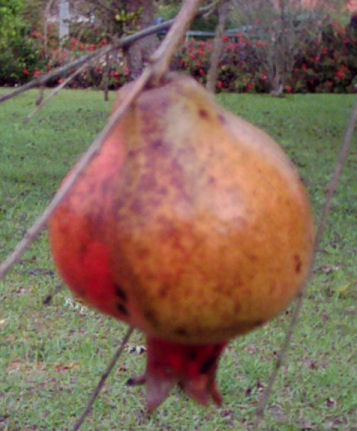

Punica granatum (Pomegranate)
Shrub or small, up to 23 feet tall, rich branched tree from the family Punicaceae. The leaves are arranged opposite or in clusters, they are ovate and lanceolate, 1.6 to 4 inches long and leathery. The flowers are terminal or axillary, individually or in groups, are of a fiery red color and are about 1.2 inches long with 3 to 7 petals, which surround numerous stamens.
The fruits are 2.4 to. 4.8 inches large berries with thick, leathery and yellowish red or red-colored fruit skin at maturity, at the head the sepals are remaining. The numerous seeds are surrounded by a red transparent, jelly-like, angular shaped fruit pulp, which constitutes the edible part of fruit. The taste of the fruit is sour-sweet wine with a subtle aroma.
The pomegranate tree is native from Iran into Northern India. Even in ancient times the plant was cultivated in the Mediterrean area. It is now cultivated throughout the tropics and subtropics, but also in temperate climates such as in Hungary, Switzerland and the German and Austrian wine-growing regions, is even hardy in milder and summer-warm regions of Germany. The plant is very unassuming and resistant to drought, frost and salt.
The fruits are either eaten in-natura as a fruit or processed into juice or grenadier syrup. In Western Asia pomegranate juice is very popular. In addition, the pulp is removed from the fuit and pressed through a sieve. In India the pulp is dried and sold as a spice (anardana) and is used in folk medicine as a remedy in diarrhea and dysentery.
In our front garden stands one flowering and fruiting shrub.

Close-up view of the fruit of the pomegranate in August 2009.
Back to the Agricultural Plant List
Updated by Joachim Jaeck on April 2nd, 2011